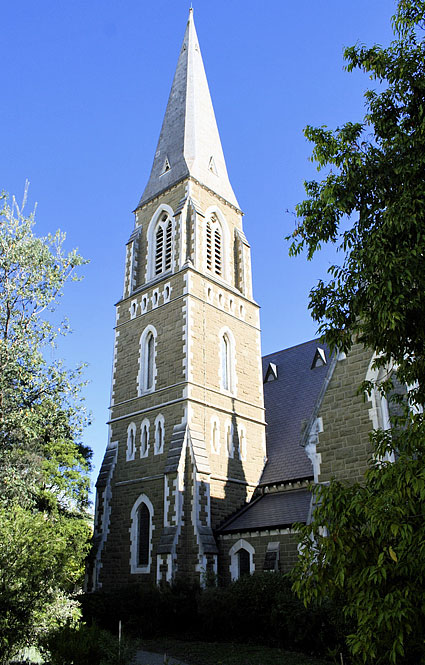TOORAK UNITING CHURCH
This church was built as the Toorak Presbyterian Church. It was designed by the Melbourne architectural firm of Reed & Barnes in a comparable Frenchified Gothic idiom to Holy Trinity, Balaclava, St Mary's, Caulfield and Ormond College at the University of Melbourne. The foundation stone was laid on 24 May 1875 and the building opened on 20 January 1876, providing accommodation for 470 people. The initial cost was £5580. The spire, 100 feet in height, was completed in 1878 at a cost of £1550. In order to accommodate growing congregations, second transepts, apse and vestries were added to the designs of J.F. Smart and were opened on 20 October 1889, all at a cost of £3450. The seating capacity of the church was thereby increased to 750 persons.
Joseph Reed, who was born in Cornwall around 1823 and died in Melbourne in 1890 must be rated as the most successful of Melbourne's 19th century architects. He arrived in Melbourne in 1853, winning the competition to design the Melbourne Public Library in 1854. Other major buildings which followed included the Melbourne Town Hall, the Exhibition Building and the original Wilson Hall at the University of Melbourne. The mansion Rippon Lea is also his work, together with the Scots', Independent (St Michael's) and Wesley Churches in the city.
The Toorak church was built in Barrabool stone, with limestone dressings from Oamaru, New Zealand. It has a complex plan, incorporating a tall tower and broach spire to the right of the main facade with a prominent stair turret. There are rare double transepts, diminutive aisles and an apsidal end which accommodates vestries rather than the altar one would expect in Anglican and Catholic churches. The original organ was sited within the apse, but this was moved in 1941 to the right transept and the space utilised for the communion table and elders' stalls. The wall behind was covered by an ornate cloth specially designed and woven in London for church use.
The interior fittings include fine cedar pews and 12 carved elders' chairs and canopies in an arts and crafts idiom made by Thear & Company, of Geelong, possibly to the design of John Scarborough who carried out similar work at the Littlejohn Memorial Chapel, Scotch College. Each seat bears a carved symbol denoting a saint. The carved communion table, in Tasmanian blackwood, was made by Robert Prenzel in 1910. The carved wooden pulpit was the gift of two members of the congregation while the octagonal wooden font is made of Tasmanian blackwood. There are many memorial plaques to prominent local families mounted along the walls.
The stained glass includes a large window by Ferguson & Urie at the rear erected in 1882 by Francis Ormond as a memorial to his wife. The large window in the left transept is a memorial to Francis Ormond while that on the right commemorates Sir James Macbain, KCMG. There are several windows by J. Ballantine & Son, of Edinburgh, who also exported glass to St Andrew's Kirk, Ballarat and St George's Church, Geelong. More recent windows include examples by Christian and Napier Waller, while some 20th century windows have been relocated from behind the organ to freestanding screens within the church.
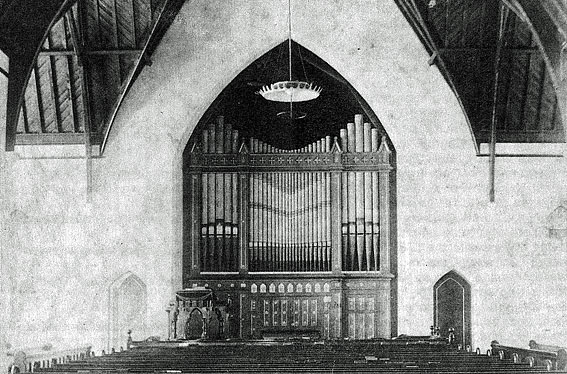
Photo: JRM
The first organ was by the Kew organbuilder Alfred Fuller and was built for the 1880 Melbourne Exhibition and was centrally placed in the apse. The organ was described in The Illustrated Australian News, 6 November 1880, page 211 shortly after the opening of the 1880 Exhibition:
In the gallery of the South transept will be found an organ built by Mr. A. Fuller, of Main Road, Kew. It has forty stops, three manuals and an independent pedal organ, one stop of which, the 16 feet trombone, with wooden pipes, is said to be the first made in the colony. Each sounding board or organ is constructed with pneumatic lever pallets, to render the touch perfectly light and free to the player. The construction of the swell organ has received careful study, in order to ensure a complete crescendo. The organ has six composition pedals, each having a separate combination of stops. The metal pipes and reeds are of the best London make. The great organ has the following stops:- open diapason, stopped diapason, clarabella, dulciana, principal, dolcan, waldflute, twelfth, fifteenth, mixture, trumpet. Swell: Bourdon, open diapason, stopped diapason, keraulophon, principal, gemshorn, flageolette, fifteenth, cornopean, hautboy, clarion. Choir: open diapason, viol de gamba, viola, principal, flute, piccolo, cremona, orchestral oboe. Pedal: open diapason, bourdon, trombone. Couplers: swell to great, great to choir, swell to choir, pedal to great, pedal to swell, pedal to choir, and octave coupler. The organ is arranged to be supplied with noiseless feeders either by hand or hydraulic power, which is a great improvement upon the old flap valve usually adopted.
The organ had a very colourful case with both the façade pipes and case timbers elaborately painted, possibly reflecting Fuller’s sojourn in the United States en route to Australia.
It was rebuilt by George Fincham & Sons Pty Ltd in 1926 and 1940 (when it was removed from the apse and divided on either side of the right transept), and a new drawstop console was provided in 1957. By this stage most of the integrity of Fuller’s organ had been entirely lost and it was moved to St Leonard’s College in Brighton where it was extensively rebuilt by S.J. Laurie Pty Ltd and reduced to two manuals.
The 1957 specification follows:
GREAT
Double Open Diapason
Open Diapason I
Open Diapason II
Claribel
Dulciana
Principal
Harmonic Flute
Twelfth
Fifteenth
Trumpet
Swell to Great Sub
Swell to Great
Swell to Great Super
Choir to Great Sub
Choir to Great
Choir to Great Super
SWELL
Bourdon A
Open Diapason
Stopped Diapason
Gamba
Viol d’Orchestre
Voix Celeste
Principal
Fifteenth
Cornopean
Oboe
Clarion
Sub Octave
Unison Off
Octave
Tremulant
CHOIR (enclosed)
Flute
Dulciana
Vox Angelica
Flute
Nazard
Piccolo
Clarinet
Spare slide
Sub Octave
Unison Off
Super Octave
Tremulant
Swell to Choir
PEDAL
Open Diapason
Bourdon
Echo Bourdon
Principal
Bass Flute
Octave Quint
Fifteenth
Trombone
Great to Pedal
Swell to Pedal
Choir to Pedal
|
16
8
8
8
8
4
4
2-2/3
2
8
16
8
8
8
8
8
4
2
8
8
4
8
8
8
4
2-2/3
2
8
16
16
16
8
8
5-1/3
4
16
|
A
TC
TC
B
C
A
B
C
C
B
wood
|
The present organ was built by the prominent English organbuilder Peter Collins, of Redbourn, near St Albans, and opened in 1980. It has an unusual divided layout employing mechanical action, with an extended tracker console. The swell and great divisions are in the right case and the pedal in the left, which includes a rare 32ft reed stop with half-length wooden pipes in the bass. The case is of Brazilian cedar with pipe shades carved in sugar pine by John Brennan representing the communicating arts. The instrument has two manuals and 34 speaking stops. Some revoicing and rearrangement has since taken place by Knud Smenge.
GREAT
Bourdon
Principal
Rohr Flute
Octave
Hohl Flute
Quint
Octave
Wald Flute
Tierce
Mixture
Cymbel
Trumpet
Tremulant
II / I
SWELL
Wood Gedact
Viol da Gamba
Celeste
Principal
Koppel Flute
Octave
Octave
Scharf
Sesquialtera
Basson
Schalmey
Krumhorn
Tremulant
PEDAL
Principal
Subbass
Octave
Pommer
Wide Octave
Mixture
Fagot
Posaune
Trumpet
Cornett
I / Pedal
II / Pedal
II Octave / Pedal
Great Pistons to Pedal
Swell Pistons to Pedal
Compass: 58/30
Mechanical key action
Electric stop action
Adjustable combination action
|
16
8
8
4
4
2-2/3
2
2
1-3/5
IV
II
8
8
8
8
4
4
2
1
III
II
16
8
8
16
16
8
8
4
IV
32
16
8
2
|
(replaced with Flute 2 by Knud Smenge)
|
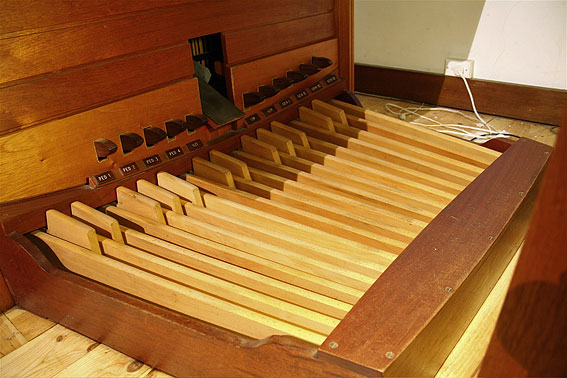
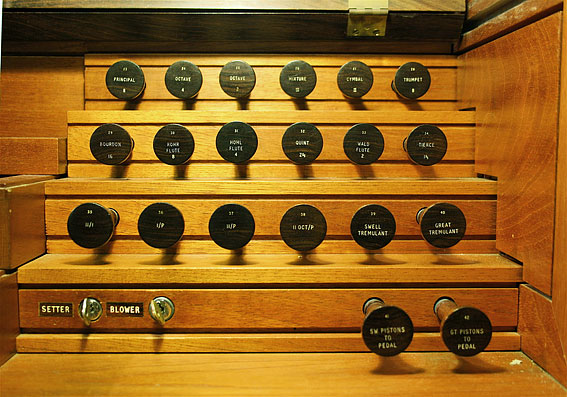
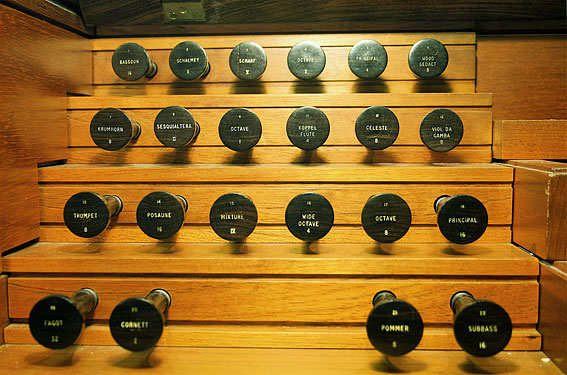
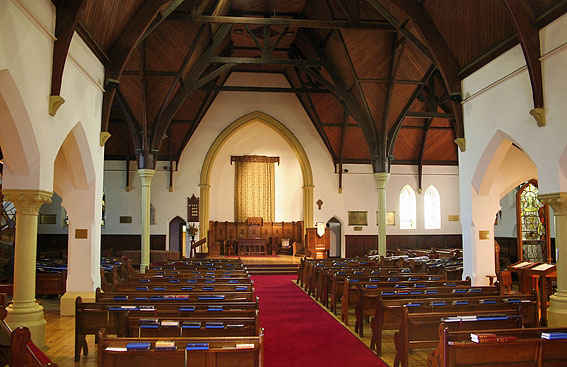
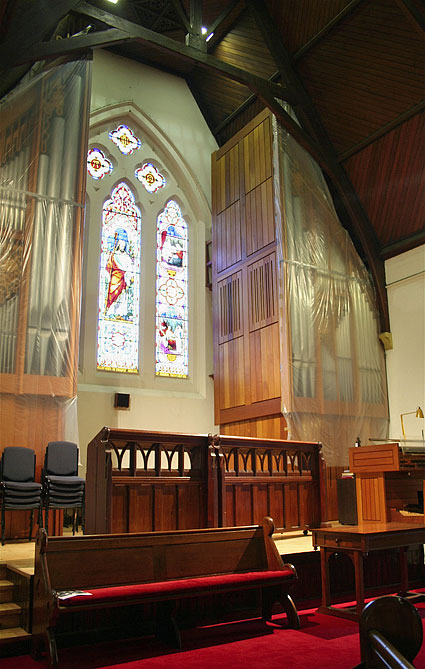
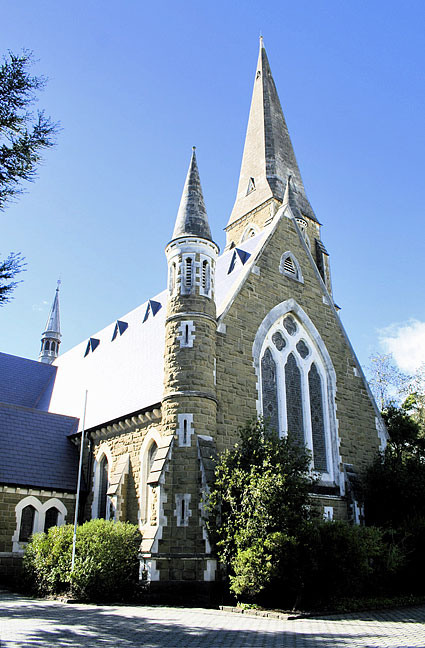
Photos: Trevor Bunning (April 2009)
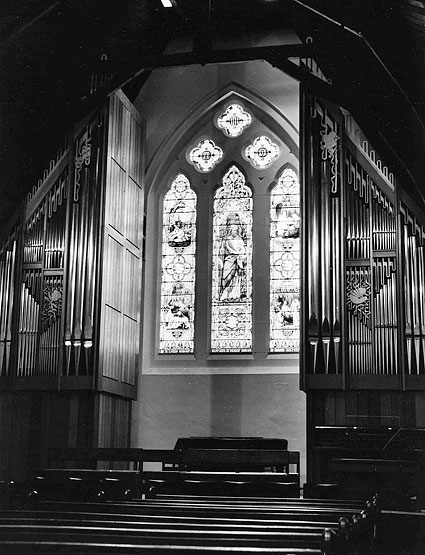
Photo: JRM
John Maidment
5 May 2009

